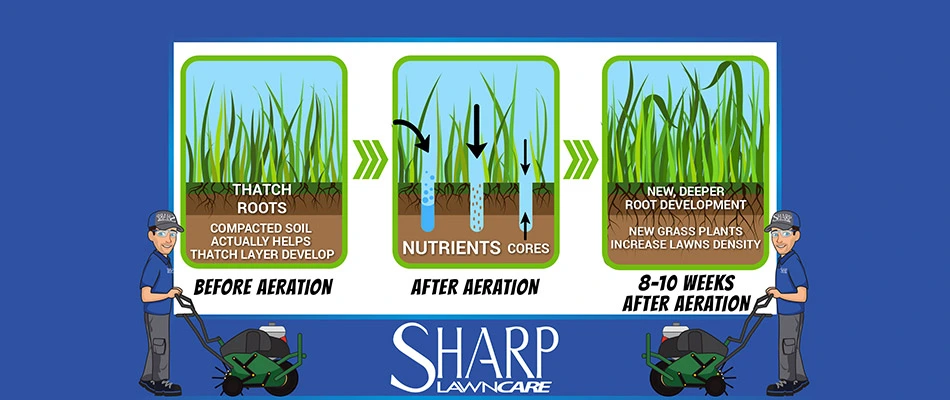Spring and Fall Aeration
Proper seeding and pest/weed control are critical pieces of the puzzle that is building and maintaining a healthy, beautiful lawn. Aeration is another of those pieces.
Surely, you’ve noticed the flawlessly curated greens of a typical golf course. This is partially because greenskeepers understand the importance of aeration. In fact, many golf courses undergo aeration at least five times a year. Homeowners’ lawns do not need the treatment as frequently as that, but they should receive it at least once per year, with twice being preferable.
Knowing when to aerate, what equipment to use, and how to follow up are the keys to effective aeration. The professionals at Sharp Lawn Care know all that and are ready to take care of this for you, but we also like for you to have an understanding of the how and the why behind all of this. We’re not like that mechanic who tells you all the parts and servicings your car needs but doesn’t explain any of it!
What is Aeration? What Happens?
Aeration is a process whereby small cores of soil are removed from the turf. In essence, aeration creates temporary “holes” in the lawn.
Although these “holes” are small, they do indeed represent disturbances in the soil. Some will view them as unsightly and may think that the aeration process seems to be counterproductive to having a beautiful lawn. As a matter of fact, many grounds managers have a love/hate relationship with aeration because it temporarily disrupts the perfect smoothness of their greens even though they understand the benefits.
We can’t deny that the immediate results of aeration can look a little ugly, but we do promise that aeration pays off. To use a football analogy, think of mowing, seeding, and pest control as the quarterbacks, running backs, and wide receivers scoring the points and getting all the attention; and think of aeration as the guards and tackles who make all that happen, not so glamorous but quietly essential.
How Does it Work? What Are the Benefits?
What aeration does is help manage decaying organic matter from plants; it also reduces compaction of soil, controls the thatch layer, and helps create a smoother surface over time. Finally, it allows air, water, and other nutrients to reach and penetrate the roots of your grass. This leads to stronger roots development and to increased density in the lawn.
Without aeration, the decaying organic matter becomes too thick and soaks up surface water that the roots need. That in turn leads to weaker root growth, disease, and ultimately the demise of the lawn.
When Should Aeration Take Place?
Aeration works best at times when grass growth is fast and strong. For cool-weather grasses such as the types we have in the Sioux City Area, those times are spring and fall because that is when temperature and rain conditions are best for growth. In the summer, a lawn is typically under stress from heat and drought, and that is not a good time to aerate.
(Just in case you’re wondering when the best time for aerating warm-weather grasses is, it’s the summer.)
Spring can be tricky because you don’t want to aerate too early or too late. Aerating too early risks missing the period of rapid growth, and the soil disturbances may promote the growth of weeds. A careful application of fertilizer and a pre-emergent weed treatment can help with this, but it is best to consult with a professional for this. Done incorrectly, it can be disastrous; if, for example, you apply a pre-emergent treatment and then seed, the herbicide will prevent not just weeds from growing but your grass as well.
The risk of aerating too late in the spring is that it may be too close to the heat of summer to realize the benefits. Again, it is best to consult a professional who knows your areas’s climate and growing conditions well.
In the fall, aeration works best early because there is ample time for the soil to recover and for the grass to grow ahead of the dormancy it undergoes during winter.
If you are going to aerate just once per year, fall is best because it is less complicated. However, we recommend that aerating in both spring and fall is the way to go for ideal results.
After Aeration, What Should You Do?
Watering the lawn following aeration is important.
Another thing to consider after aeration is overseeding. This is what we commonly refer to as reseeding, planting a fresh layer of grass seeds. Doing this after aeration can work well because there is better contact between the seeds and the soil, which stimulates better growth. However, as we explained in the prior section, you should not reseed if you already applied a pre-emergent weed treatment, as this will prevent your grass from growing.
If you are not reseeding, then it helps to apply fertilizer and weed killer shortly after aeration.
Seasonal aeration, then, is an important component of maintaining a healthy lawn. And remember, the professionals at Sharp Lawn Care are ready to achieve that strong, healthy lawn and save you a lot of invaluable time in the process!
If you would like a lawn aeration quote for your property, contact Sharp Lawn Care!
We’ve linked tools and products in this article that may help you complete this work yourself. As an Amazon Associate, we earn from qualifying purchases.




Comments (0)
Thanks for your comment!
Thanks for your feedback! Your comments have been successfully submitted! Please note, all comments require admin approval prior to display.
Error submitting comment!
There is a problem with your comment, please see below and try again.